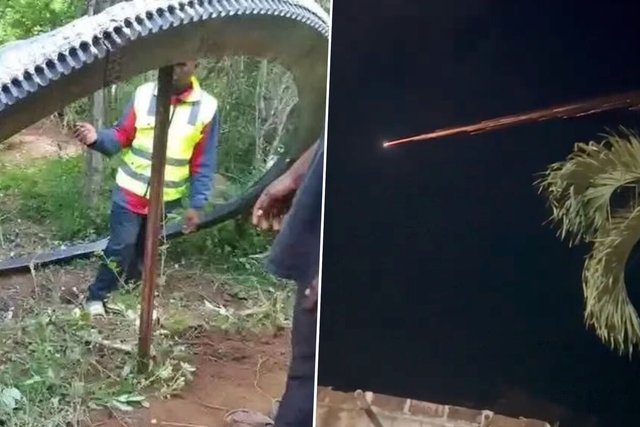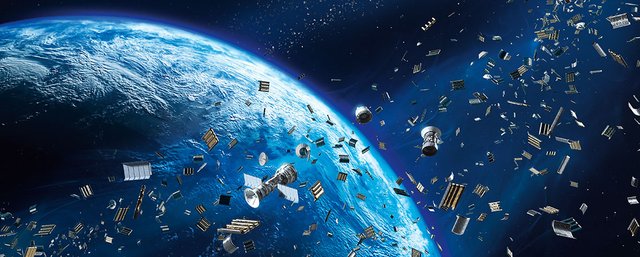Three large pieces of space junk re-enter every day. How safe are we down here?/Cada día reingresan tres grandes piezas de basura espacial, ¿que tan seguros estamos aquí abajo?

Source
In the last five years, we have witnessed the fall to Earth of various space objects that, due to their size, the materials they are made of, or the angle of re-entry, overcome the resistance of the atmosphere and do not disintegrate in it. The sizes of the pieces found range from 10 cm, part of a battery pallet discarded from the International Space Station, to the core stage of a Chinese Long March 5B rocket, with an estimated mass of between 17 and 23 tons and a length of about 30 meters.
En el último lustro hemos asistido a la caída a la Tierra de diversos objetos espaciales que, bien por su tamaño, por los materiales que lo componen o por el ángulo de reentrada, superan la resistencia de la atmósfera y no se desintegran en ella. Los tamaños de los trozos hallados van desde los 10 cm de parte de un palé de baterías desechado desde la Estación Espacial Internacional hasta aa etapa central de un cohete chino Larga Marcha 5B, con una masa estimada de entre 17 y 23 toneladas y un tamaño de unos 30 metros.
Added to all this is the desperate race for space, not only to launch rockets to Mars or the Moon, but also the desire to launch entire constellations of artificial satellites, for a wide variety of purposes. These satellites are being launched practically daily, both by private companies and various governments. Logically, the more devices fly overhead, the greater the chance of them falling on our heads.
A todo esto tenemos que unir la desesperada carrera espacial, no solo por lanzar cohetes a Marte o la Luna sino por la ansiedad de lanzar constelaciones enteras de satélites artificiales, con los fines más variopintos que se están lanzando prácticamente a diario, tanto de compañías privadas como de los distintos gobiernos. Lógicamente, cuantos más artefactos nos sobrevuelan más aumenta la posibilidad de nos caigan en la cabeza.

Source
According to reports from the European Space Agency (ESA) and other experts, an average of three sizable objects (such as old satellites or rocket stages) re-enter Earth's atmosphere every day, and it's estimated that only once Starlink has completed launching its 30,000 satellites will this number reach fifteen dangerous re-entries every day. To date, there have been no human casualties, but how safe are we down here?
Según informes de la Agencia Espacial Europea (ESA) y otros expertos, se estima que una media de tres objetos de tamaño considerable (como satélites viejos o etapas de cohetes) reingresan a la atmósfera terrestre cada día y se calcula que, solo cuando Starlink haya completado el lanzamiento de sus 30.000 satélites esta cifra llegaría a las quince reentradas peligrosas cada día. Hasta la fecha no hubo que lamentar ninguna pérdida humana pero, ¿hasta que punto estamos seguros aquí abajo?
According to experts, although the figure of three re-entries of space debris per day sounds alarming, the probability of a piece causing a disaster in a densely populated area is extremely low. Most objects that re-enter the atmosphere burn up and disintegrate due to friction with the air; only the largest objects or those made of resistant materials can survive re-entry and reach the ground in fragments.
Pues según los expertos, aunque la cifra de tres reingresos diarios de basura espacial suena alarmante, la probabilidad de que un trozo cause un desastre en una zona densamente poblada es extremadamente baja. La mayoría de los objetos que reingresan a la atmósfera se queman y desintegran debido a la fricción con el aire, solo los objetos más grandes o aquellos hechos de materiales resistentes pueden sobrevivir el reingreso y llegar al suelo en fragmentos.

Source
Most of the Earth's surface is covered by oceans (approximately 70%) or sparsely populated areas. This means the probability of an object falling directly into a densely populated area is very small. Furthermore, space agencies around the world actively track thousands of orbiting objects and can predict, within a certain margin of error, when and where the largest objects will re-enter the atmosphere.
La mayor parte de la superficie de la Tierra está cubierta por océanos (aproximadamente el 70%) o zonas escasamente pobladas. Esto significa que la probabilidad de que un objeto caiga directamente sobre un área densamente habitada es muy pequeña. Además Las agencias espaciales de todo el mundo rastrean activamente miles de objetos en órbita y pueden predecir, con cierto margen de error, cuándo y dónde reingresarán a la atmósfera los objetos más grandes.
The real problem with space debris is not on Earth, but in space itself. The accumulation of orbital debris increases the risk of collisions between operational satellites and other objects, which could generate even more fragments and endanger future space missions and communications infrastructure. Efforts are primarily focused on mitigating the creation of new space debris and managing existing debris in orbit to ensure the safety of future space operations.
El verdadero problema de la basura espacial no está en la Tierra, sino en el espacio mismo. La acumulación de desechos orbitales aumenta el riesgo de colisiones entre satélites operativos y otros objetos, lo que podría generar aún más fragmentos y poner en peligro futuras misiones espaciales y la infraestructura de comunicaciones. Los esfuerzos se centran principalmente en mitigar la creación de nueva basura espacial y en gestionar los desechos existentes en órbita para garantizar la seguridad de las operaciones espaciales futuras.
More information/Más información
https://www.space.com/space-exploration/satellites/3-big-hunks-of-space-junk-crash-to-earth-every-day-and-its-only-going-to-get-worse
Hi, @mauromar,
Thank you for your contribution. Your post has been manually curated.
- Delegate to @ecosynthesizer and vote @symbionts as a witness to support us.
- Explore Steem using our Steem Blockchain Explorer
- Easily create accounts on Steem using JoinSteem
No me contenta saber que vamos a tener muchos más satélites y viajes a la Luna o Marte, sino que ya están cayendo enormes piezas sobre nuestras cabezas. ¿Quien controla eso que está cayendo al azar?
Gracias por compartir, saludos y éxitos.